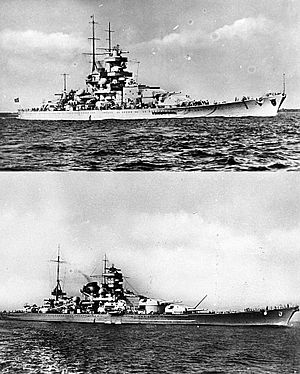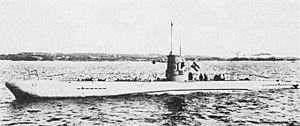Operation Nordmark facts for kids
Quick facts for kids Operation Northern March / Unternehmen Nordmark |
|
|---|---|
| Part of the Phoney War of the Second World War | |

Map of the North Sea
|
|
| Location | North Sea |
| Planned by | Marinegruppe West |
| Commanded by | Wilhelm Marschall Alfred Saalwächter |
| Objective | Attack British merchant shipping |
| Date | 18 February 1940 |
| Outcome | Inconclusive |
| Casualties | Nil |
Operation Northern March (Unternehmen Nordmark) was a mission carried out by German warships during the Second World War. From February 18 to 20, 1940, a group of German ships, including two battleships and a heavy cruiser, sailed into the North Sea. Their goal was to attack British merchant ships traveling between Norway and the Shetland Islands.
This mission was a response to the Altmark incident, where the British had captured a German supply ship. The Germans also hoped to create confusion, helping their own ships get back home safely. The British quickly spotted the German ships and held back a convoy that was heading to Norway. British battleships from the Home Fleet were sent to stop the German ships. However, the German group only found neutral ships and realized they had been discovered. Bad weather and confusing reports from British submarines meant they couldn't track the German ships well. The German ships returned to their base on February 20. At the same time, German U-boats (submarines) in the area sank several ships, including a British destroyer.
Contents
Why This Mission Happened
After the British found and destroyed the German cruiser Admiral Graf Spee, many ships returned to the Home Fleet. However, the German navy staff (called Seekriegsleitung) decided that bigger fleet operations were possible. The commander of Naval Group West (Marinegruppe West), Alfred Saalwächter, was ordered to plan more missions. These missions would involve the Scharnhorst-class battleships Scharnhorst and Gneisenau, and the heavy cruiser Admiral Hipper.
Admiral Wilhelm Marschall had been criticized earlier for returning to port after sinking HMS Rawalpindi in November 1939. The new plan was to attack ships carrying goods from Norway and disrupt convoys in the Atlantic Ocean.
The Naval Group West believed that engine problems with Scharnhorst and Gneisenau made operations in the Atlantic too risky. Instead, they wanted to attack convoys traveling between Bergen, Norway, and the Shetland Islands. They also hoped to use U-boats to attack British Home Fleet ships during another battleship mission. The mission was delayed several times because of icy winter conditions, which kept U-boats in port. There was no information about any Allied convoys sailing, and then Gneisenau was damaged by ice. This operation was also meant to help the German tanker Altmark return to Germany. At the time, the Germans didn't know that the tanker had already been beached. Seven U-boats were sent to the northern North Sea to scout for the German fleet and attack British ships.
Getting Ready for the Mission
On February 17, the Germans detected a British convoy sailing north along the east coast of Britain. They thought another convoy might be nearby, so the German operation was ordered for February 18. Admiral Marschall decided that if his ships were spotted leaving port, he would turn back once it got dark.
Because of the bad weather, Marschall moved the ships from Wilhelmshaven into the Wangerooge Channel on the evening of February 17. Early on February 18, the British received reports from RAF Bomber Command aircraft. These reports said that ships seemed to be stuck in ice near their bases. British submarines on patrol were redirected. Marschall then sailed with Scharnhorst, Gneisenau, Admiral Hipper, and the destroyers Z20 Karl Galster and Z21 Wilhelm Heidkamp into the North Sea, heading towards Bergen in Norway.
The Mission Begins
The destroyers Z1 Leberecht Maass, Z5 Paul Jacobi, Z6 Theodor Riedel, and Z7 Hermann Schoemann, along with torpedo boats Seeadler and Luchs, protected the German ships as they sailed into the North Sea at 11:00 a.m. These ships were then sent to the Skagerrak. The destroyer Z9 Wolfgang Zenker had to turn back because it was damaged by ice.
With only two destroyers left, Marschall headed towards 61°N 00°E / 61°N 0°E. He sent seaplanes to scout as far north as Statlandet. No enemy ships were found by these planes or by other aircraft from Germany. German intelligence did not know that on February 19, there was only one eastbound convoy, which had been held back. They also didn't know that the British Home Fleet was already at sea.
Convoy HN 12 was near Scotland, and the convoy going the other way (ON convoy) was sent to Scapa Flow until the danger passed. Ships of the Home Fleet were already at sea, covering the attack on Altmark. More battleships were ordered from the River Clyde to join them. In bad weather, the submarine HMS Salmon reported seeing Scharnhorst, Gneisenau, Hipper, and Königsberg heading south very fast.
The German naval staff wanted Marschall to wait another day between Shetland and Bergen. They agreed with Naval Group West to attack ships near Shetland. Naval Group West tried to influence Marschall by sending frequent reports of British activity:
Wireless traffic remains normal. No recognisable effect of operation. Heavy enemy forces expected near Clyde and in North Channel. Further stay in operations area on 20 February probably not dangerous with prospects of success.
The German naval staff disagreed with this suggestion but did not stop it. By 3:00 p.m. on February 19, Marschall had not seen any enemy ships. He believed the British had found out about the operation and had stopped their convoys. He decided that waiting would be useless and ordered his ships to return home. The submarine L23 signaled that a cruiser and two destroyers were heading south-east. This caused a lot of confusion at the Admiralty. Both British submarines were detected and had to dive deep to escape. This meant they couldn't chase the German ships. The submarines then turned back before reaching areas where German U-boats were patrolling. The German ships reached Wilhelmshaven on February 20, just as the Home Fleet ships arrived in the North Sea and the Norway-bound ON convoy sailed.
U-boat Attacks
While the main German fleet was out, several German U-boats were also active:
- The Type IIB U-boat U-9 sank a ship of 1,213 tons off Norway on February 11.
- U-10 sank two ships totaling 6,356 tons.
- U-14 sank four ships totaling 5,320 tons on February 15 and 16 off the Scottish coast.
- On February 21, U-57 sank a 10,191-ton ship and damaged a 4,966-ton ship east of the Orkney Islands.
- U-23 sank the destroyer HMS Daring, which was protecting the westbound Convoy HN 12, on February 18. It also sank another ship on February 19 and finished off the 4,966-ton ship damaged by U-57 on February 22.
- U-61 sank two ships totaling 5,703 tons east of the Shetland Islands and the Orkney Islands on February 18.
- U-63 sank a 4,211-ton ship off Kirkwall, Orkney, on February 24, 1940.
What Happened Next
The German naval staff was disappointed that the mission failed. They thought it had a good chance of success. They decided that the commander of Naval Group West should not just send intelligence reports. Instead, he should send orders to the force commander if he seemed unsure. The naval staff didn't realize that their own understanding of the situation was wrong. They didn't know what the British forces were doing.
Grand Admiral Erich Raeder told Hitler that the convoy heading north to Kirkwall had continued its journey. Raeder wanted another operation and believed that better intelligence would reduce the risks. The Germans still didn't know that the British Home Fleet had been in the area and had not been noticed by them.
Before the next mission on February 25, a group of destroyers was sent to the Dogger Bank to attack British fishing boats in Unternehmen Wikinger (Operation Viking). This mission ended in disaster when one destroyer was sunk by a German Heinkel He 111 bomber, and another was sunk by a mine. The loss of two destroyers forced the next planned operation to be delayed. Repairs to Scharnhorst took until March 4. On March 1, the order for the invasion of Denmark and Norway (Operation Weserübung) was received. This required a huge effort, so other operations were put off indefinitely.




